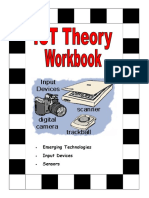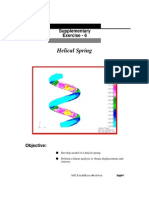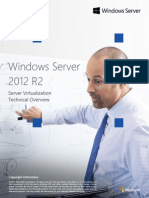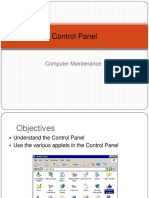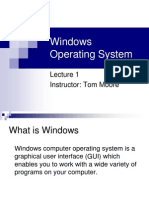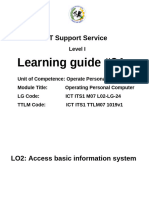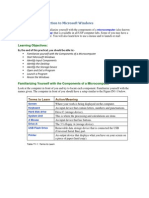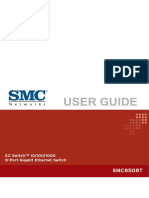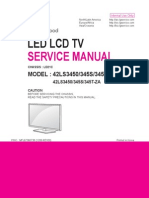ECDL Module 2 Notes
Uploaded by
Natalie CharalambousECDL Module 2 Notes
Uploaded by
Natalie CharalambousSt.
Michael Foundation
ECDL Module 2 Vers. 1.0
ECDL Module 2 Using the computer and managing files
Starting the computer ......................................................................................................2 The Desktop....................................................................................................................2 The Mouse ......................................................................................................................3
Mouse terms................................................................................................................................ 3 Pointers ....................................................................................................................................... 3 Change Mouse Properties .......................................................................................................... 4
Windows .........................................................................................................................4 Start Button .....................................................................................................................6 Using the Help Function ..................................................................................................6 Shutting down the Computer ...........................................................................................7 Icons ...............................................................................................................................8 Viewing the Computers drives.........................................................................................9 Checking Windows Version Number/RAM/CPU ............................................................10 Customizing Computers Desktop Settings....................................................................10 Setting the Time/Date....................................................................................................11 Setting the screen Resolution........................................................................................12 Desktop background/Screen Saver ...............................................................................12 Regional Settings ..........................................................................................................13 Sound Settings..............................................................................................................13 Print Screen ..................................................................................................................14 Create a Desktop Shortcut ............................................................................................14 Adding Programs to the Start menu ..............................................................................14 Arranging Desktop Icons ...............................................................................................15 Install/Uninstall Programs..............................................................................................15 Files and Folders...........................................................................................................15 Windows Explorer .........................................................................................................17 Change File/Folder Status.............................................................................................17 Create a new folder .......................................................................................................18 Renaming a Folder/File .................................................................................................18 Deleting a Folder/File ....................................................................................................18 Copying a Folder/File ....................................................................................................18 Moving a Folder/File......................................................................................................18 Counting Files ...............................................................................................................18 Backing Up....................................................................................................................19 Formatting Disks ...........................................................................................................19 Compressing/Decompressing Files ...............................................................................19 Viruses ..........................................................................................................................20 Text Files ......................................................................................................................20 Printers..........................................................................................................................20
Default Printer ........................................................................................................................... 20 Check Print jobs ........................................................................................................................ 20 Adding a new Printer ................................................................................................................. 21 Prevention ................................................................................................................................. 20 Wildcards................................................................................................................................... 18 Common File Types .................................................................................................................. 16 Parts of a window ........................................................................................................................ 5
Resources.....................................................................................................................21
-1-
St. Michael Foundation
ECDL Module 2 Vers. 1.0
Starting the computer
After ensuring that the computer is plugged in an electricity socket, press the button on the system tower. When you switch on the computer it will perform a POST (Power On System Test) this is performed in the BIOS (Basic input/output system), this generally has the appearance of a black background with white text scrolling on it. This test checks that all the hardware installed in the computer is functioning, it also keeps track of the system time.
The Desktop
ICONS
DESKTOP
SYSTEM CLOCK TASKBAR VOLUME
START BUTTON
-2-
St. Michael Foundation
ECDL Module 2 Vers. 1.0
Start Button: Lets you quickly go to functions such as programs, settings and documents Task Bar: Displays open windows, and lets you quickly switch from one window to another by clicking on its icon on the taskbar. Icons: Click on an icon to easily open the application associated with it. Volume: move the slider up and down to decrease/increase the system loudspeaker volume. System Clock: lets you change the time or date settings of your computer, it also lets you change the time zone.
The Mouse
Mouse terms
Click: Press and release left mouse button Right Click: Press and release right mouse button. Double Click: Double click left mouse button in quick succession. Drag and Drop: Press left mouse button on target and whilst keeping it depressed drag to desired location. Hover: Place mouse button on target to activate (e.g. place over Font Color icon and the help tip will appear.
Pointers
Hyperlink Wait (Timer)
Standard mouse pointer Stop
Standard mouse pointer with help Standard mouse pointer with wait (Timer)
-3-
St. Michael Foundation
ECDL Module 2 Vers. 1.0
Change Mouse Properties
To change the properties of the mouse select Start > Settings > Mouse. The window that appears lets you change the properties of the mouse by clicking on the Tabs at the top of the window you can select various configurations.
Windows
Screenshot of desktop showing two windows open
-4-
St. Michael Foundation
ECDL Module 2 Vers. 1.0
Parts of a window
Title Bar
Menu Bar
Standard Tool Bar
Navigation Bar
Close Window Minimize Window Maximize/Restore Window
Figure 1 shows an example of a drop down window
-5-
St. Michael Foundation
ECDL Module 2 Vers. 1.0
Start Button
By clicking on the Start button the following shortcuts are shown:
Program Shortcuts Document Shortcuts OS Settings Shortcuts Search for Files/Folders System Software Help Run applications by typing in commands Shut down Computer
If you right click on the Start button you will get the following menu:
Windows Explorer Windows Settings
Using the Help Function
To use the Windows help function click Start > Help and a new window will open, either select a help topic or type in keywords in your search and start the search
-6-
St. Michael Foundation
ECDL Module 2 Vers. 1.0
Click to start search
Type in Keywords Pick a predefined search topic
Shutting down the Computer
The correct procedure to shutdown a computer is Start > Shutdown the following screen will appear. This screen gives you the option to:
Put Computer in Standby mode Shutdown Computer
Restart Computer
In the event that your computer hangs the correct procedure to restart the computer is to press Ctrl+Alt+Del twice in rapid succession.
-7-
St. Michael Foundation
ECDL Module 2 Vers. 1.0
Icons
Commonly used desktop icons are:
My Documents: Default receptacle for all your documents
My Computer: Shows all drives/folders/files in your computer
My Network Places: shows networked computers (If on a network)
Recycle Bin: stores deleted folders/files
Internet Explorer: Shortcut button to open your web browser
You can right click on an icon to activate a drop down menu of commands and configurations related to that icon.
Figure 2 shows the drop down menu of commands attached to the My Computer icon. Icons in windows may be viewed in any one of the following formats, to change these select View from the Menu bar and select the format you require:
-8-
St. Michael Foundation
ECDL Module 2 Vers. 1.0
Windows XP gives you 5 optional views of your icons in windows.
Viewing the Computers drives
Double clicking on the My Computer icon on the desktop opens the view of your computers drives information
Hard Disk Drive (HDD)
Floppy Drive (FDD) Compact Disk Rewritable Drive (CDRW) Compact Disk Drive (CDROM)
-9-
St. Michael Foundation
ECDL Module 2 Vers. 1.0
Checking Windows Version Number/RAM/CPU
Right click on the My Computer Icon on your desktop and select Properties from the drop down window, the following window will appear.
System Software type
CPU Type Amount of RAM
Customizing Computers Desktop Settings
All changes to the computers desktop settings may be performed from the Control Panel. This may be accessed by clicking Start > Settings > Control Panel.
Figure 3 shows some of the icons on the authors computers Control Panel
- 10 -
St. Michael Foundation
ECDL Module 2 Vers. 1.0
Setting the Time/Date
To set the Time/Date of your computer you may either do this by clicking on the Date/Time icon in control panel
Alternatively you can double click on the time located at the bottom right hand corner of your Taskbar, the following window will appear.
Figure 4 shows the Date/Time settings options window
- 11 -
St. Michael Foundation
ECDL Module 2 Vers. 1.0
Setting the screen Resolution
To change the screen resolution, right click on any empty space on the Desktop, from the drop down menu that appears select Properties, on the window that appears select Settings.
Move slider to increase/decrease resolution
Window showing colour depth
Common Screen Resolution sizes are: 640 x 480 (largest Icons) 800 x 600 1024 x 760 (Smallest icons, sharpest images)
Common Colour Depth settings are: 256 Colours 16 Bit (16 million colours) 24 Bit (24 million colours) 32 Bit (32 million colours)
Desktop background/Screen Saver
To change the desktop background or the screen saver, right click on any empty space on the desktop, from the window that appears either select the Desktop tab or the Screensaver tab to make the required changes.
- 12 -
St. Michael Foundation
ECDL Module 2 Vers. 1.0
Regional Settings
Start > Settings > Control Panel > Regional and Language Options.
Tabs to change Currency, Time and Date format
Tabs to change from Imperial to Metric system of measurement
Sound Settings
To edit the sound settings you can either right click on the speaker icon on the right hand side of the Taskbar, and select Adjust Audio Properties
Alternatively you can select the Sound and Audio Devices icon located in the Control Panel.
- 13 -
St. Michael Foundation
ECDL Module 2 Vers. 1.0
Print Screen
You may be required to print screenshots of regions or full screen images from your computer, to do this press the Prt Scr (Print Screen Button) located on your keyboard, then go to any application where you can paste images (e.g. Paint or Word) and select Paste from the Edit menu.
Create a Desktop Shortcut
To create a desktop shortcut right click on the icon that you require the shortcut to, from the dropdown menu select Send To > Desktop (create shortcut).
Figure 5 shows the stages to create a shortcut to the program files folder.
Adding Programs to the Start menu
You can add programs to the Start menu as long as your computer running Windows XP is not set to Classical mode. To add programs select Start > All Programs right click on the program you would like to add to the Start menu and select Pin to Start menu.
- 14 -
St. Michael Foundation
ECDL Module 2 Vers. 1.0
Arranging Desktop Icons
To arrange icons automatically on the desktop, right click any clear space and from the menu that appears select Arrange Icons By > Auto Arrange
To position icons in positions that you would like, untag the Auto Arrange.
Install/Uninstall Programs
To install a program insert the CD (Compact Disk) that the program came on, the autorun will automatically start the installation, follow program installation instructions. To uninstall a program select Start > Settings > Control Panel > Add/Remove Programs and select the application you would like to uninstall.
Files and Folders
When you save a document or a spreadsheet in your computer you are creating a file with a name that you specify, these will have a file extension; a three character recognition tag that would determine what application that file is associated with e.g. Module2.xls > .xls tells us that this file is an Excel spreadsheet file Multiple files and folders may be stored inside folders; we can imagine that a folder is a sort of envelope that can contain other envelopes (Subfolders) and/or files.
The Folder Icon (The subfolder icon is similar)
- 15 -
St. Michael Foundation
ECDL Module 2 Vers. 1.0
Common File Types
Icon File Extension .doc Application Word
.xls
Excel
.mdb
Access
.ppt
Powerpoint
.txt or rtf
Text or Rich Text Format Adobe Portable Document Format
.jpg
Picture
.gif, .tif or bmp
Picture
.wmv or .wma
Windows Media Video or Audio Compressed File Executable Audio Audio Audio Video Web Page Temporary
.zip .exe .wav .au .mp3 .mpeg, .avi .htm .tmp
- 16 -
St. Michael Foundation
ECDL Module 2 Vers. 1.0
Windows Explorer
You might want to view the hierarchy of the computer, to do this right click on the Start button and select Explore; this will open the Windows Explorer.
The Windows Explorer lets you explore the hierarchy of your computer
Change File/Folder Status
To change the File or folder status, right click on it and select the Properties from the drop down menu and change the required attributes.
Attributes such as Read only may be set here
- 17 -
St. Michael Foundation
ECDL Module 2 Vers. 1.0
Create a new folder
Open window where the new folder is required: File > New > Folder
Renaming a Folder/File
Right Click on the Folder/File icon and from the drop down menu select Rename; rename folder/file.
Deleting a Folder/File
Right click on the Folder/File icon, and from the drop down menu select Delete.
Copying a Folder/File
Right click on the Folder/File icon, and from the drop down menu select Copy. Go to the folder where you would like to place your copied folder/files and select Edit > Paste from the Menu bar.
Moving a Folder/File
Right click on the Folder/File icon, and from the drop down menu select Cut. Go to the folder where you would like to place your copied folder/files and select Edit > Paste from the Menu bar. NOTE: to copy multiple folders files hold down the SHIFT key as you drag a box around the icons. If you want to select Folders/Files at random hold down the CTRL button on your keyboard as you select the icons with your mouse.
Counting Files
To count files of a specified type in any location: Start > Search > All Files and Folders Select the area you want to Look In e.g. Drive C: Type in the name or the file or if you do not know it, then type in the file extension, start the search and the computer will give you a readout of all files of that type and quantities. The window will also show you the file size and date last amended if you set the viewing options to Details
Wildcards
? * > > Will replace one character Will replace a string
- 18 -
St. Michael Foundation
ECDL Module 2 Vers. 1.0
Backing Up
It is imperative that you take regular backups to avoid loosing any work in case of damage to your computer/Files To backup a floppy disk, right click on drive A: and from the drop down menu select Copy Disk and follow the instructions.
Formatting Disks
To format any disk, right click on the icon referring to that disk and select Format Disk. Note: you cannot format a disk that contains your system software, formatting a disk wipes that disk clean and information stored on it cannot be recovered once it is formatted.
Compressing/Decompressing Files
To compress or decompress a file (only in Windows XP, you will require an application such as Winzip in previous versions) right click on the file and select Send To > Compressed (zipped) Folder.
To decompress (expand) a compressed folder right click on the icon of the compressed file and select Extract All.
- 19 -
St. Michael Foundation
ECDL Module 2 Vers. 1.0
Viruses
There are FOUR main categories of viruses: Trojan Horse: A virus that hides inside a legitimate program, and is designed to look harmless. Worm: This type of virus replicates itself into the computer system, this will in time use up all the processing power of the computer until it stops. Logic Bomb: This virus is only activated when a specified condition is satisfied e.g. when the user opens a specified application. Time Bomb: this virus is activated at a preprogrammed specific time and/or date.
Prevention
It is very important that all computers have anti virus software that is continually, preferably daily, updated.
Text Files
To create a text file select Start > All Programs > Accessories > Notepad.
Printers
Default Printer
To change the default printer select: Start > Settings > Printers and Faxes on the window that opens right click the icon of the printer that you are required to make as your default printer, and from the drop down menu select Set as Default Printer.
Check Print jobs
To check pending print jobs select the printer icon located at the bottom right hand side of the Taskbar and double click it, a window similar to the one below will open and show you your pending print jobs, these may de deleted if required in this window by right clicking on the print job and deleting it.
- 20 -
St. Michael Foundation
ECDL Module 2 Vers. 1.0
Adding a new Printer
To add a new printer: Start > Settings > Printers and Faxes > Add a Printer Follow instructions on the screen.
Resources
Practice paper and notes may be acquired from: http://www.stmichaelfoundation.org/ecdl.htm http://www.ghalliem.net Using a search engine such as Google and using the keywords given as an example: +ECDL + module 2 +Practice +Papers.
- 21 -
You might also like
- ICDL Computer & Online Essentials 1.0 QRGNo ratings yetICDL Computer & Online Essentials 1.0 QRG6 pages
- ICDL Computer & Online Essentials 1.0 Win10:Chrome:OL2016 Cert Eng - ResultNo ratings yetICDL Computer & Online Essentials 1.0 Win10:Chrome:OL2016 Cert Eng - Result1 page
- Book 2 - Emerging Technology, Input Devices, SensorsNo ratings yetBook 2 - Emerging Technology, Input Devices, Sensors21 pages
- ICDL Spreadsheets 2016 6.0 - Sample PDFNo ratings yetICDL Spreadsheets 2016 6.0 - Sample PDF50 pages
- Chapter 1A & Chapter 1B: Introducing Computer Systems Looking Inside The Computer SystemNo ratings yetChapter 1A & Chapter 1B: Introducing Computer Systems Looking Inside The Computer System48 pages
- ICDL Standard Syllabus Contents of The ICDL Standard ModulesNo ratings yetICDL Standard Syllabus Contents of The ICDL Standard Modules32 pages
- SSC Data Entry Operator Solved Paper: Computer General KnowledgeNo ratings yetSSC Data Entry Operator Solved Paper: Computer General Knowledge5 pages
- Programarea Pe Platforma Android: UPB - Facultatea ETTINo ratings yetProgramarea Pe Platforma Android: UPB - Facultatea ETTI42 pages
- ICDL Cyber Security 2.0 - Sentral College Penang - Icdlasia.org (1) 2No ratings yetICDL Cyber Security 2.0 - Sentral College Penang - Icdlasia.org (1) 2115 pages
- Harman-Kardon Avr156-230 Avr158-230 Av Receiver PDFNo ratings yetHarman-Kardon Avr156-230 Avr158-230 Av Receiver PDF139 pages
- How To Configure How The Offline Address Book Is Downloaded When You Use Outlook in Cached Exchange ModeNo ratings yetHow To Configure How The Offline Address Book Is Downloaded When You Use Outlook in Cached Exchange Mode2 pages
- Windows 10 - Overview: System RequirementsNo ratings yetWindows 10 - Overview: System Requirements20 pages
- Paul Fischer - Introduction To GUI With Java Swing - 2005No ratings yetPaul Fischer - Introduction To GUI With Java Swing - 2005319 pages
- ICDL Advanced Word Processing 2016 3.0 - QRGNo ratings yetICDL Advanced Word Processing 2016 3.0 - QRG5 pages
- Windows Server 2012 R2 Server Virtualization White PaperNo ratings yetWindows Server 2012 R2 Server Virtualization White Paper116 pages
- Course Name: Computer Sciences: Windows 7No ratings yetCourse Name: Computer Sciences: Windows 764 pages
- Information Technology Support Service: Learning Guide #16No ratings yetInformation Technology Support Service: Learning Guide #169 pages
- Unit Objectives: Use System Configuration Tools View System Information and Logs Use Task Manager Edit Configuration FilesNo ratings yetUnit Objectives: Use System Configuration Tools View System Information and Logs Use Task Manager Edit Configuration Files67 pages
- Windows Operating System: Instructor: Tom MooreNo ratings yetWindows Operating System: Instructor: Tom Moore22 pages
- Entoto Polytechnic College: Sector: Economic Infrastructure Sub-Sector: Business and Finance Basic Clerical Work Level-INo ratings yetEntoto Polytechnic College: Sector: Economic Infrastructure Sub-Sector: Business and Finance Basic Clerical Work Level-I17 pages
- Fujitsu Lifebook LH520 (Quanta FK1) Laptop Schematics - Quanta - fk1No ratings yetFujitsu Lifebook LH520 (Quanta FK1) Laptop Schematics - Quanta - fk137 pages
- Android Application To Convert Speech To Text andNo ratings yetAndroid Application To Convert Speech To Text and5 pages
- Ordinary Seaman or Unlicenced Engineer or Tankerman TraineeNo ratings yetOrdinary Seaman or Unlicenced Engineer or Tankerman Trainee5 pages
- Hacking With Kali Linux - A Comprehensive Beginner's Guide to Learn Ethical Hacking. Practical Examples to Learn the Basics of Cybersecurity. Includes Penetration Testing With Kali Linux by ITC ACADEMY100% (1)Hacking With Kali Linux - A Comprehensive Beginner's Guide to Learn Ethical Hacking. Practical Examples to Learn the Basics of Cybersecurity. Includes Penetration Testing With Kali Linux by ITC ACADEMY91 pages
- A Pic Real Time Clock Ic RTC Using The ds1307 - Compress PDFNo ratings yetA Pic Real Time Clock Ic RTC Using The ds1307 - Compress PDF6 pages
- Manpower Requisition Form 1. Manpower Requisition Form 2. JDNo ratings yetManpower Requisition Form 1. Manpower Requisition Form 2. JD1 page
- 1555331373.somalia Databases and Beneficiary Registries For Cash Transfer ProgrammingNo ratings yet1555331373.somalia Databases and Beneficiary Registries For Cash Transfer Programming39 pages
- Application For Registration of Worker'S Association (Was)67% (6)Application For Registration of Worker'S Association (Was)1 page
- Infineon-Design Guide Boost Type CCM PFC ICE3PCSxx-AN-v02 00-EN PDFNo ratings yetInfineon-Design Guide Boost Type CCM PFC ICE3PCSxx-AN-v02 00-EN PDF26 pages
- ICDL Computer & Online Essentials 1.0 Win10:Chrome:OL2016 Cert Eng - ResultICDL Computer & Online Essentials 1.0 Win10:Chrome:OL2016 Cert Eng - Result
- Book 2 - Emerging Technology, Input Devices, SensorsBook 2 - Emerging Technology, Input Devices, Sensors
- Chapter 1A & Chapter 1B: Introducing Computer Systems Looking Inside The Computer SystemChapter 1A & Chapter 1B: Introducing Computer Systems Looking Inside The Computer System
- ICDL Standard Syllabus Contents of The ICDL Standard ModulesICDL Standard Syllabus Contents of The ICDL Standard Modules
- SSC Data Entry Operator Solved Paper: Computer General KnowledgeSSC Data Entry Operator Solved Paper: Computer General Knowledge
- Programarea Pe Platforma Android: UPB - Facultatea ETTIProgramarea Pe Platforma Android: UPB - Facultatea ETTI
- ICDL Cyber Security 2.0 - Sentral College Penang - Icdlasia.org (1) 2ICDL Cyber Security 2.0 - Sentral College Penang - Icdlasia.org (1) 2
- Harman-Kardon Avr156-230 Avr158-230 Av Receiver PDFHarman-Kardon Avr156-230 Avr158-230 Av Receiver PDF
- How To Configure How The Offline Address Book Is Downloaded When You Use Outlook in Cached Exchange ModeHow To Configure How The Offline Address Book Is Downloaded When You Use Outlook in Cached Exchange Mode
- Paul Fischer - Introduction To GUI With Java Swing - 2005Paul Fischer - Introduction To GUI With Java Swing - 2005
- Windows Server 2012 R2 Server Virtualization White PaperWindows Server 2012 R2 Server Virtualization White Paper
- Information Technology Support Service: Learning Guide #16Information Technology Support Service: Learning Guide #16
- Unit Objectives: Use System Configuration Tools View System Information and Logs Use Task Manager Edit Configuration FilesUnit Objectives: Use System Configuration Tools View System Information and Logs Use Task Manager Edit Configuration Files
- Entoto Polytechnic College: Sector: Economic Infrastructure Sub-Sector: Business and Finance Basic Clerical Work Level-IEntoto Polytechnic College: Sector: Economic Infrastructure Sub-Sector: Business and Finance Basic Clerical Work Level-I
- Fujitsu Lifebook LH520 (Quanta FK1) Laptop Schematics - Quanta - fk1Fujitsu Lifebook LH520 (Quanta FK1) Laptop Schematics - Quanta - fk1
- Ordinary Seaman or Unlicenced Engineer or Tankerman TraineeOrdinary Seaman or Unlicenced Engineer or Tankerman Trainee
- Hacking With Kali Linux - A Comprehensive Beginner's Guide to Learn Ethical Hacking. Practical Examples to Learn the Basics of Cybersecurity. Includes Penetration Testing With Kali Linux by ITC ACADEMYHacking With Kali Linux - A Comprehensive Beginner's Guide to Learn Ethical Hacking. Practical Examples to Learn the Basics of Cybersecurity. Includes Penetration Testing With Kali Linux by ITC ACADEMY
- A Pic Real Time Clock Ic RTC Using The ds1307 - Compress PDFA Pic Real Time Clock Ic RTC Using The ds1307 - Compress PDF
- Manpower Requisition Form 1. Manpower Requisition Form 2. JDManpower Requisition Form 1. Manpower Requisition Form 2. JD
- 1555331373.somalia Databases and Beneficiary Registries For Cash Transfer Programming1555331373.somalia Databases and Beneficiary Registries For Cash Transfer Programming
- Application For Registration of Worker'S Association (Was)Application For Registration of Worker'S Association (Was)
- Infineon-Design Guide Boost Type CCM PFC ICE3PCSxx-AN-v02 00-EN PDFInfineon-Design Guide Boost Type CCM PFC ICE3PCSxx-AN-v02 00-EN PDF




